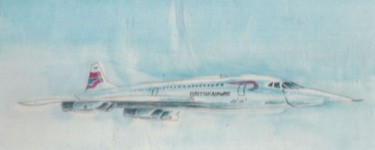3 A series of shocks
Nobody who saw the news on 25 July 2000 could forget the dreadful events of that day. I was at work when the first reports of the French Concorde crash started appearing on the internet. Later, like so many others, I watched in horror as footage was shown of Concorde F-BTSC struggling through the air with one wing ablaze. Even now, it’s disturbing to see the grim photographs or film of the wreckage, and to think of the people who lost their lives.
Shortly afterwards, British Airways’ Concordes were grounded. I sorely missed seeing them in the sky, and couldn’t help looking forward to the day when they would fly again, even though I understood the reasons why the aeroplanes had to be examined and re-tested. Recently, some French Concorde friends took me to see the site at Gonesse. The weeds have grown over the scarred ground, but there is still an eerie, ringing silence. I don’t think that will ever fade away.
Late in 2001, the Concordes returned to scheduled flight. Obviously, I was delighted to see them back in the air – but I didn’t know of the threats that now faced them. Perhaps the gravest of all resulted from the loss of life in the 9/11 terror attacks; many of the people who had died in the Twin Towers had been regular Concorde customers. The world was becoming a greyer and more dangerous place.
Initial sketches
Thanks to my work on the British Airways book, I now knew where the Concordes lived. One day in 2001, while the fleet was still grounded, I took a sketchbook and headed to Heathrow to find and study them. Little did I know what I had begun.
A wobbly start
This was my first go at drawing Concorde from life. My excuse is that I was a long way from the aircraft, peering through a car park. I found it really difficult to understand the shape and proportions, as you can probably see from the cringe-worthy effort here – she deserved better than this!
A bit more like it!
I fared a bit better when I tried working from photographs, as in this copy from an image by aviation photographer Adrian Meredith. This is actually a painting on silk, done in 2001.
The Queen’s Golden Jubilee in 2002 brought the heart-lifting sight of a flypast by Concorde G-BOAD with the Red Arrows. I had flown in from Spain earlier that day, and got home just before the event started. I turned on the TV, but watched the spectacle for real out of my window, as a procession of classic aircraft flew low across London. Finally, I saw what I had been waiting for – Alpha Delta and the Red Arrows sailed past me, looking like a flock of exotic birds led by a graceful swan. I didn’t take any photos, but I’m not sorry because I preferred to watch the flypast with my own eyes. The concordesst.com site has some fabulous images, though, which can be found here.
Everything was looking great for the big white bird, until the next bombshell dropped on 10 April 2003. I was in the supermarket when I heard a news report on their TV, saying that Concorde was to be grounded for good. I just managed to pay for my groceries and get out without anyone seeing the tears in my eyes. Surely they couldn’t do this.


